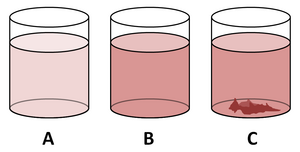Oversaturation
Supersaturation is the name given to a metastable state of a solution or vapor . Under normal conditions such an excess of the equilibrium state would be prevented by a phase transition. In the case of oversaturated systems, however, this does not occur at the expected equilibrium point of the phase diagram . The temperature range in which oversaturation can occur is also called the Ostwald-Miers range (after Wilhelm Ostwald and Henry Alexander Miers ).
Supersaturated solution
A supersaturated solution contains more of the solute than its solubility corresponds to at that temperature.
Manufacturing
When a saturated solution slowly cools down while standing still, a supersaturated solution is formed first before the excess of the dissolved substance precipitates.
Elimination of the "too much" dissolved substance
The "too much" substance that has remained in solution is eliminated through
- Shake,
- Stir,
- Evaporation of the solvent,
- Rub with a glass rod on the inner wall of the glass vessel in which the solution is stored or through
- Adding a crystal of the substance that is dissolved in the liquid - "seeding". Crystallization then begins at the sharp edges of the seed crystals.
- Introduction of energy (e.g. through vibrations or, in the case of heat cushions, through deformation energy)
Application examples
Supersaturated solutions are used, for example, to purify substances through recrystallization or to obtain crystals (also single crystals :) by means of crystallization .
Supersaturated steam
Supersaturated steam has a higher density than steam in the thermodynamic equilibrium between steam and condensate. Especially with regard to water vapor in the air , if there are no condensation nuclei ( aerosols ) in the laboratory test ( cloud chamber ), a supersaturation of a maximum of approx. 800% is shown. Under atmospheric conditions, maximum supersaturations of 100% can be observed, with supersaturations of only a few percentage points generally occurring.
Manufacturing
When steam is slowly cooled in thermodynamic equilibrium between steam and condensate, supersaturated steam is produced.
Decomposition using the example of clouds
Rain can be removed from undercooled cloud fields by "inoculating" with germs from z. B.
- Urea ,
- Sodium alginate ,
- Silver iodide or
- Dry ice
bring to excretion. This may be desirable in order to prevent hailstorms .
Subcooling of pure substance melts
A widespread application in which a broad Ostwald Miers area is exploited are hand warmers or heating pads with sodium acetate - trihydrate filling. It is liquefied at a melting temperature of 58 ° C, e.g. B. in the microwave . Even at temperatures far below the melting point - under certain circumstances down to −20 ° C - the material remains liquid as a supercooled melt in a metastable state , since the salt dissolves in its crystal water ; the water molecules form a kind of crystal lattice of their own that dissolves first.
Decomposition and heat recovery
If a metal plate (similar to the one in a cracking frog ) is pressed into the heat pad, this triggers crystallization. The cushion warms up again to the melting temperature, whereby the complete crystallization and thus the release of the latent heat can extend over a longer period of time. Possible triggers for crystallization are:
- the pressure wave that is triggered by pressing the metal plate,
- the resulting release of microscopic crystallization nuclei that get stuck in small cracks in the metal with each crystallization.
Individual evidence
- ↑ LJ Spencer : Biographical notice of Sir Henry A. Miers (1858-1942) . In: Journal of the Mineralogical Society . No. 185 , 1944, pp. 17-28 ( PDF ).
- ^ A b Walter Wittenberger: Chemical laboratory technology. 7th edition. Springer-Verlag, Vienna / New York 1973, ISBN 3-211-81116-8 , p. 100.
- ^ Arthur Lüttringhaus : Krystallisierung , in Houben-Weyl (editor: Eugen Müller): Methods of Organic Chemistry. Volume I / 1: General Laboratory Practice. , 4th edition. Georg Thieme Verlag, Stuttgart 1958, pp. 354-355.
- ↑ a b Otto-Albrecht Neumüller (Ed.): Römpps Chemie-Lexikon. Volume 6: T-Z. 8th revised and expanded edition. Franckh'sche Verlagshandlung, Stuttgart 1988, ISBN 3-440-04516-1 , p. 4404.
- ^ Seminar lecture Daniel Oriwol "Sodium acetate as latent heat storage", 2008; PDF document .
- ↑ Mansel A. Rogerson, Silvana SS Cardoso: Solidification in heat packs: I. Nucleation rate. In: AIChE Journal. 49, 2003, pp. 505-515. doi: 10.1002 / aic.690490220 .
